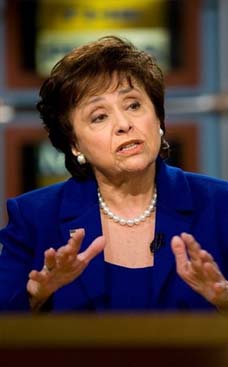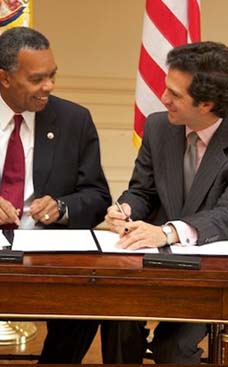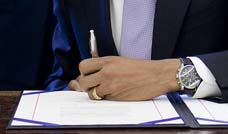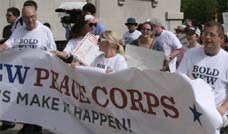
Oct. 14, 1960: In a 2 a.m. impromptu speech, presidential candidate and then-Sen. John F. Kennedy calls on students at the University of Michigan to volunteer to serve for one to two years in the developing world. Within weeks, students organized a petition drive and gathered 1,000 signatures in support of the idea, which became the Peace Corps.
Peace Corps Timeline
Peace Corps timeline: 1960 to 2011
Caption: In 1961, President John F. Kennedy hands a pen to brother-in-law Sargent Shriver after signing legislation at the White House giving the Peace Corps permanent status. Kennedy joshingly praised Shriver, head of the Corps, as "one of the most effective lobbyists Washington has seen."
It all started on Oct. 14, 1960, after a speech by President John F. Kennedy. Next year, the Peace Corps celebrates 50 years.
Oct. 14, 1960: In a 2 a.m. impromptu speech, presidential candidate and then-Sen. John F. Kennedy calls on students at the University of Michigan to volunteer to serve for one to two years in the developing world. Within weeks, students organized a petition drive and gathered 1,000 signatures in support of the idea, which became the Peace Corps.
March 1, 1961: President Kennedy signs Executive Order 10924, providing for the establishment and administration of the Peace Corps on a temporary pilot basis.
THEN AND NOW: People inspired to volunteer
June 1961: Training for the first group of Peace Corps volunteers is conducted at U.S. colleges, universities and private agencies.
Aug. 30, 1961: The first group of Peace Corps volunteers, Ghana I, arrives in Accra. They will serve as teachers.
Sept. 22, 1961: Congress approves legislation for the Peace Corps, giving it the mandate to "promote world peace and friendship" through a mission statement that endures to this day.
1962: Programs begin in 27 new countries: Afghanistan, Belize, Bolivia, Cameroon, Cote d'Ivoire, Cyprus, Dominican Republic, Ecuador, El Salvador, Ethiopia, Guinea, Iran, Jamaica, Liberia, Malaysia, Nepal, Niger, Peru, Sierra Leone, Somalia, Sri Lanka, Tanzania, Thailand, Togo, Tunisia, Turkey and Venezuela. As of June 30, at least 2,816 volunteers are in the field.
1966: More than 15,000 trainees and volunteers are serving in the field. Historically, this is the highest number of Peace Corps volunteers.
September 1966: Lillian Carter, the mother of President Carter, departed for Peace Corps service at age 68 as a public health Volunteer in India, one of many who set the standard for older volunteers for generations to come.
1971: With Executive Order 11603, President Nixon folds the Peace Corps and several other programs (including VISTA, Foster Grandparent Program, Retired Senior Volunteer Program and the Service Corps of Retired Executives) into a new federal volunteer agency called ACTION. The Peace Corps' original congressional mandate, however, remains "unchanged."
1974: Christopher Dodd of Connecticut, a volunteer in the Dominican Republic from 1966-68, and Paul Tsongas of Massachusetts, a volunteer in Ethiopia from 1962-64, are the first returned Peace Corps volunteers elected to the U.S. House of Representatives. They both go on to be elected to the U.S. Senate.
1977: Carolyn Robertson Payton is appointed Peace Corps director by President Carter. She was the first female and the first African American to be Peace Corps director.
1979: Peace Corps closes its post in Afghanistan. The Peace Corps entered Afghanistan in 1962, and 1,652 volunteers served in the country until the program ended in 1979, when a Soviet-sponsored regime took control of the country.
1981: Peace Corps becomes an independent federal agency and is no longer a part of ACTION.
1983: The longest-serving Peace Corps director, Loret Miller Ruppe, and USAID director M. Peter McPherson signed a Memorandum of Understanding (MOU) to establish the Small Project Assistance (SPA) Program. Since then, the SPA program has operated continuously to support small, community-initiated grants, as well as technical assistance and training activities. Today, the SPA program funds activities in over 40 Peace Corps posts.
1985: For the first time since Peace Corps' inception, there are more women entering service than men. Women continue to be in the majority until present day.
1990: The first group of Peace Corps volunteers to serve in Central and Eastern Europe depart. The first countries were Poland, Hungary, the Czech Republic and the Slovak Republic.
Oct. 7, 1993: Carol Bellamy becomes the first Returned Peace Corps Volunteer to serve as director of the agency. She is followed by RPCVs Mark Schneider (1999-2001), Ronald Tschetter (2006-08) and Aaron Williams (2009-present).
June 1993: The first group of English teachers leave for China.
1995: Peace Corps sends three Volunteers to Antigua to help rebuild homes damaged by Hurricane Luis. This pilot effort marks what will come to be known as Peace Corps Response, which provides short-term humanitarian service to countries worldwide.
1996: The Peace Corps celebrates its 35th anniversary. Nearly 7,000 volunteers are serving in 94 developing countries.
1997: Thirty-three Peace Corps volunteers depart to work with teachers in post-apartheid South Africa.
2005: For the first time in the agency's history, volunteers are deployed domestically when Peace Corps Response aids the Federal Emergency Management Agency's relief operations in the Gulf Coast region after hurricanes Katrina and Rita.
2009: After the 1994 genocide, Peace Corps returns to Rwanda, where volunteers begin working in secondary education and on prevention, care and treatment of HIV/AIDS.
2009: President Obama signs H.R. 3288, an omnibus appropriations package that includes $400 million for Peace Corps operations in fiscal year 2010, the largest-ever budget appropriation from Congress.
2010: Peace Corps reopens three historic programs in Sierra Leone, Indonesia and Colombia and surpasses the 200,000 mark in total Americans who have served overseas with Peace Corps.
2011: Peace Corps commemorates its 50th anniversary.













